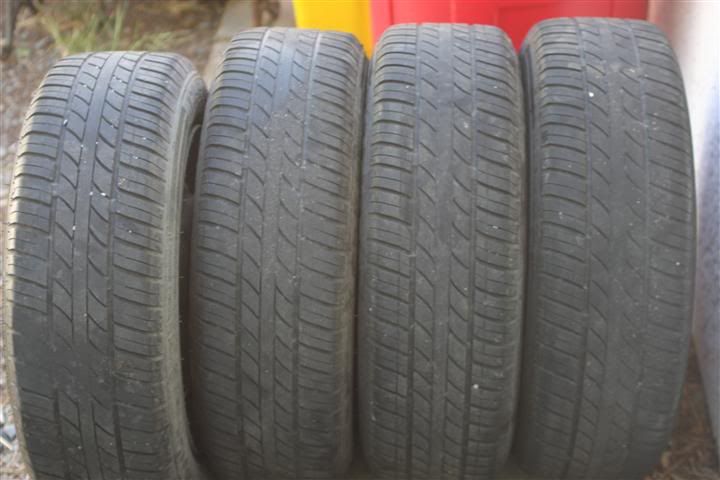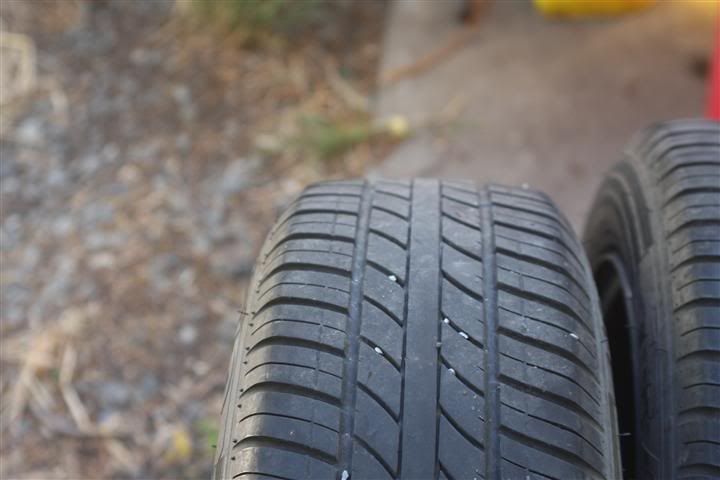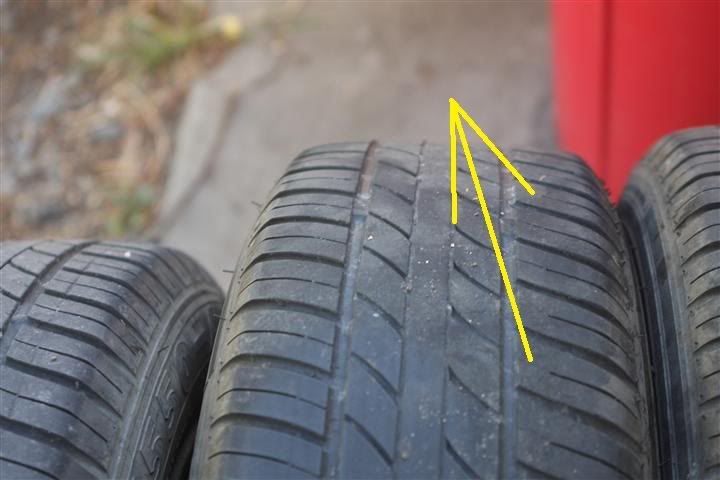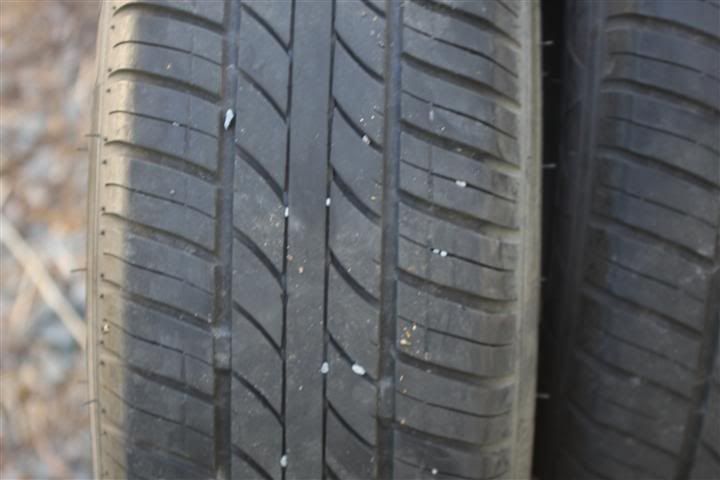 05-12-2011, 10:48 PM
05-12-2011, 10:48 PM
|
#51 (permalink)
|
|
Pishtaco
Join Date: Jun 2009
Location: Bay Area, California
Posts: 1,485
Thanks: 56
Thanked 286 Times in 181 Posts
|
I just took these tires off my xB last week. I ran them for 20,000 miles, and they were on the car when I bought it with 37,000 miles on the odometer. I don't know if they're the original tires, or a set of cheapies that replaced the originals.

Last week I would have said they show normal treadwear, despite being inflated to maximum sidewall (44 psi). Here's one of the rears, which still has about 30% tread depth. It looks like normal treadwear to me.

But then I noticed the two front tires were worn considerably more in the center - a classic sign of overinflation. Note the tread blocks right of center are worn to zero tread depth.

Here's a different view. First the best rear tire, looking good with tread depth deep enough to pick up pebbles.

Next, the worst front tire. Again showing significant center tread wear. There's not enough tread depth to pick up pebbles in the center, because the tire is virtually bald there (yellow arrows). Contrast the center with the outside edge areas in blue, which show about 30% tread depth.

I'm not buying the claims of those who claim normal treadwear with overinflation. It's not borne out by my personal experience. I'm sure some people do get normal treadwear inflating to and beyond sidewall pressure, but I've got proof that I didn't.
Three of my four old tires show accelerated center wear, indicating it's not an alignment problem.
__________________
Darrell
Boycotting Exxon since 1989, BP since 2010
Have you ever noticed that anybody driving slower than you is an idiot, and anyone going faster than you is a maniac? George Carlin
Mean Green Toaster Machine
49.5 mpg avg over 53,000 miles. 176% of '08 EPA
Best flat drive 94.5 mpg for 10.1 mi
Longest tank 1033 km (642 mi) on 10.56 gal = 60.8 mpg

Last edited by SentraSE-R; 05-18-2011 at 03:17 AM..
|
|
|

|
|
The Following User Says Thank You to SentraSE-R For This Useful Post:
|
|
 Today Today
|
|
|
|
 Other popular topics in this forum...
Other popular topics in this forum...
|
|
|
|
 05-12-2011, 11:36 PM
05-12-2011, 11:36 PM
|
#52 (permalink)
|
|
(:
Join Date: Jan 2008
Location: up north
Posts: 12,762
Thanks: 1,585
Thanked 3,558 Times in 2,220 Posts
|
Especially since fwd cars tend to wear the tread out on the edges first on the front, steering tires.
|
|
|

|
 05-13-2011, 01:49 AM
05-13-2011, 01:49 AM
|
#53 (permalink)
|
|
EcoModding Apprentice
Join Date: Jul 2010
Location: New Jersey
Posts: 191
Tahoe - '95 Chevrolet Tahoe LT 90 day: 13.22 mpg (US) SRX - '04 Cadillac SRX AWD XL - '05 Harley Davidson Sportster XL 90 day: 49.97 mpg (US) Alero - '02 Oldsmobile Alero GLS Corvette - '75 Chevrolet Corvette Stingray
Thanks: 3
Thanked 8 Times in 8 Posts
|
Well I read most of the thread and skimmed some and have heard over and over that you are going off the sidewall pressure? why? sidewall is not the proper inflation for the tire. read your owners manual or look at the door jamb and run your pressures from there as a starting point.
Every model car is different, if you have a 4cyl or a 8 with the same size tires one will need more or less air to allow for the weight difference. front or RWD? Yup once again cars balance and distribution of weight throughout the car will need to be taken into account.
I have trailer tires that say 50 PSI but that is under certain loads. Your car is set up using the maximum capacities that is allowable for the vehicle. So if you have a 8 person 3 row crossover then you may have different mfr. recommendations depending on how many occupants in the car.
Weight and your suspension is critical for your car to maintain its optimum handling and performance. blown shocks and overinflated tires may net a monster rough ride that has your ABS brake system working overtime every-time you hit a pothole, then again many people may not care because they are netting 2mpg better.
I am not telling you how to setup your car and there is no universal PSI number but there is one thing we all can agree on is that under inflated tires are bad thing unless you go to the race track with me where I set my slicks anywhere from 6 to 15 PSI on most days, weather and track conditions vary.
__________________
2012 Chevrolet Traverse *active*
2002 Oldsmobile Alero GLS *active*
2002 S10 2wd p/u 139,000mi. *active*
1975 Corvette Stingray *active*
1994 Camaro Z28 Convertible 149k *Sold 2013*
1998 Blazer ZR2 189k *Sold 2012*
1995 Tahoe LT 250k *Sold 2011*

|
|
|

|
 05-17-2011, 04:05 PM
05-17-2011, 04:05 PM
|
#54 (permalink)
|
|
Pishtaco
Join Date: Jun 2009
Location: Bay Area, California
Posts: 1,485
Thanks: 56
Thanked 286 Times in 181 Posts
|
The door jamb/owners manual inflation pressures are only recommendations for your car if your goal is comfort. The manual often recommends you increase pressures when carrying full passenger/cargo loads.
The tire mfr sidewall inflation pressures are recommendations for safety under maximum load conditions.
We inflate our tires for our cars' intended purposes, so what's best depends on your car and your purpose. High pressure suits hypermiling and high speeds. Low pressure suits off-roading and maximum traction.
__________________
Darrell
Boycotting Exxon since 1989, BP since 2010
Have you ever noticed that anybody driving slower than you is an idiot, and anyone going faster than you is a maniac? George Carlin
Mean Green Toaster Machine
49.5 mpg avg over 53,000 miles. 176% of '08 EPA
Best flat drive 94.5 mpg for 10.1 mi
Longest tank 1033 km (642 mi) on 10.56 gal = 60.8 mpg

|
|
|

|
 05-17-2011, 05:31 PM
05-17-2011, 05:31 PM
|
#55 (permalink)
|
|
Master EcoModder
Join Date: Sep 2010
Location: Denver, CO
Posts: 1,300
Thanks: 315
Thanked 179 Times in 138 Posts
|
Quote:
Originally Posted by NHRABill

I am not telling you how to setup your car and there is no universal PSI number but there is one thing we all can agree on is that under inflated tires are bad thing unless you go to the race track with me where I set my slicks anywhere from 6 to 15 PSI on most days, weather and track conditions vary.
|
The "universal" PSI is the sidewall max, the safest pressure for the tire. Anything less is "under-inflated". When I go to the race track, I am well over 40 psi on my tires, and the placard in the door jamb is 28 psi. If I run the car's "recommended" pressure, I would roll my tires onto the sidewalls with the grip and G forces.
__________________
I'm not coasting, I'm shifting slowly.

|
|
|

|
 05-17-2011, 07:47 PM
05-17-2011, 07:47 PM
|
#56 (permalink)
|
|
EcoModding Apprentice
Join Date: Jul 2010
Location: New Jersey
Posts: 191
Tahoe - '95 Chevrolet Tahoe LT 90 day: 13.22 mpg (US) SRX - '04 Cadillac SRX AWD XL - '05 Harley Davidson Sportster XL 90 day: 49.97 mpg (US) Alero - '02 Oldsmobile Alero GLS Corvette - '75 Chevrolet Corvette Stingray
Thanks: 3
Thanked 8 Times in 8 Posts
|
Quote:
Originally Posted by UFO

The "universal" PSI is the sidewall max, the safest pressure for the tire. Anything less is "under-inflated". When I go to the race track, I am well over 40 psi on my tires, and the placard in the door jamb is 28 psi. If I run the car's "recommended" pressure, I would roll my tires onto the sidewalls with the grip and G forces.
|
Sorry, I have to disagree the MAX pressure of a tire is not the safest pressure it is called max for a reason. Yes I understand the logic and results of over inflating the tire for daily commuting use I do it myself, but a fully loaded car or truck with overinflated tires or tires set to the Max is dangerous. This is an obvious observation by most anyone with an ounce of common sense.
The reason I mentioned the Mfr. pressure as a safe starting point and not that of the tire is because the car is designed to be safe at those conditions. If you removed your stock tires and rims from your car increased the size or changed the height of your sidewalls then the mfr. recommendations goes out the window and can only be used as a guideline.
if you are into racing then you understand that all tires have different compounds i wouldn't put the Hoosier quicktimes on my truck to tow my car to the racetrack the same as I wouldn't run a set of McCreary's on my wifes Cadillac. The tires compound, diameter, height, width environmental conditions and vehicle you put them on varies so much that there is NO universal Max pressure. I run 10PSI in my truck tires when running on the beach of NC outer banks I need to drop my motorcycle pressure down to 25 to get better traction when it is a 90 degree hot day and I am cursing the back roads of Princeton, NJ along the river having a good time. i used to run 10psi in my supercomp dragster on a average night where I would run 14 psi in my ultra quick 8 vette under the same conditions. When I was commuting I would run Max psi in the daily driver and no more after I tore the tread off of the tire while driving at a high rate of speed spinning me out at 70mph on the Garden state parkway in southbound summer congestion.
The point is know your car and there is no right answer take all factors into consideration for your ride.
I can't imagine worrying about rolling a sidewall when racing. a 40 or even 50 series tire on a scca course would shred on a high HP and heavy weighted car before it rolled even if set to 10 psi.
__________________
2012 Chevrolet Traverse *active*
2002 Oldsmobile Alero GLS *active*
2002 S10 2wd p/u 139,000mi. *active*
1975 Corvette Stingray *active*
1994 Camaro Z28 Convertible 149k *Sold 2013*
1998 Blazer ZR2 189k *Sold 2012*
1995 Tahoe LT 250k *Sold 2011*

|
|
|

|
|
The Following User Says Thank You to NHRABill For This Useful Post:
|
|
 05-17-2011, 08:02 PM
05-17-2011, 08:02 PM
|
#57 (permalink)
|
|
(:
Join Date: Jan 2008
Location: up north
Posts: 12,762
Thanks: 1,585
Thanked 3,558 Times in 2,220 Posts
|
Among EMers, you alone are reporting the only tread separation from max psi. 
Last edited by Frank Lee; 05-17-2011 at 10:02 PM..
|
|
|

|
 05-17-2011, 08:11 PM
05-17-2011, 08:11 PM
|
#58 (permalink)
|
|
Master EcoModder
Join Date: Sep 2010
Location: Denver, CO
Posts: 1,300
Thanks: 315
Thanked 179 Times in 138 Posts
|
Quote:
Originally Posted by NHRABill

Sorry, I have to disagree the MAX pressure of a tire is not the safest pressure it is called max for a reason. Yes I understand the logic and results of over inflating the tire for daily commuting use I do it myself, but a fully loaded car or truck with overinflated tires or tires set to the Max is dangerous. This is an obvious observation by most anyone with an ounce of common sense.
|
And the reason is what? The tire is designed to function at load with that much weight, so the shear resistance of the rubber can take it, ergo lighter loads will not stress it as much. Perhaps if your car's dampers are not maintained, the higher pressure can highlight worn shocks, but tire pressure is not the issue.
Quote:
Originally Posted by NHRABill

The reason I mentioned the Mfr. pressure as a safe starting point and not that of the tire is because the car is designed to be safe at those conditions. If you removed your stock tires and rims from your car increased the size or changed the height of your sidewalls then the mfr. recommendations goes out the window and can only be used as a guideline.
|
The manufacturer recommended that pressure to minimize road noise and keep a nice ride, a higher pressure does not make the tire less safe. You build more heat at lower pressures, and that is what causes tire failure.
Quote:
Originally Posted by NHRABill

if you are into racing then you understand that all tires have different compounds i wouldn't put the Hoosier quicktimes on my truck to tow my car to the racetrack the same as I wouldn't run a set of McCreary's on my wifes Cadillac. The tires compound, diameter, height, width environmental conditions and vehicle you put them on varies so much that there is NO universal Max pressure. I run 10PSI in my truck tires when running on the beach of NC outer banks I need to drop my motorcycle pressure down to 25 to get better traction when it is a 90 degree hot day and I am cursing the back roads of Princeton, NJ along the river having a good time. i used to run 10psi in my supercomp dragster on a average night where I would run 14 psi in my ultra quick 8 vette under the same conditions. When I was commuting I would run Max psi in the daily driver and no more after I tore the tread off of the tire while driving at a high rate of speed spinning me out at 70mph on the Garden state parkway in southbound summer congestion.
The point is know your car and there is no right answer take all factors into consideration for your ride.
I can't imagine worrying about rolling a sidewall when racing. a 40 or even 50 series tire on a scca course would shred on a high HP and heavy weighted car before it rolled even if set to 10 psi.
|
Exactly. Different tires have different geometries and different compounds, making the car manufacturers' recommendations useless. What I meant to say with my track car is tire pressure must be higher to keep from scrubbing the shoulders to maintain the contact patch. You get better grip by maintaining the tire shape with higher pressure. Same concept, just don't exceed the sidewall maximum.
And I have drag raced as well; lower pressure gets better grip but you better not run at highway speeds or you will overheat them. And don't corner with them aired down either.
__________________
I'm not coasting, I'm shifting slowly.

|
|
|

|
 05-17-2011, 08:15 PM
05-17-2011, 08:15 PM
|
#59 (permalink)
|
|
EcoModding Alien Observer
Join Date: Mar 2008
Location: I flitter here and there
Posts: 547
Thanks: 6
Thanked 78 Times in 65 Posts
|
Quote:
Originally Posted by Enginator

Running tire pressure at 45 psi or higher increases danger of loss of control, bouncing and the suspension is NOT tuned for it. It can affect stopping distance. Plus the tires will not last as long.
Last time I checked last fall, about the cheapest tires out there for a GEO for instance were around $50 each and rising. Saving $75 dollars over a year on fuel you would probably burn more than that off the overinflated tires.
Different story for engineered, lowered rolling resistance tires. You will save approximately as much in fuel as the extra cost of the tires. So it is a break even.
Enginator
|
For a decent ride and handling maybe 1/2 way between the door sticker and the sidewall max?
Assuming a 5% mpg gain from LRR tires...they will pay for them selves over 40-60K miles?
__________________
Carry on humans...we are extremely proud of you. .................. 
Forty-six percent of Americans believe in the creationist view that God created humans in their present form at one time within the last 10,000 years. GALLUP POLL 
|
|
|

|
 05-18-2011, 12:04 AM
05-18-2011, 12:04 AM
|
#60 (permalink)
|
|
EcoModding Apprentice
Join Date: Jul 2010
Location: New Jersey
Posts: 191
Tahoe - '95 Chevrolet Tahoe LT 90 day: 13.22 mpg (US) SRX - '04 Cadillac SRX AWD XL - '05 Harley Davidson Sportster XL 90 day: 49.97 mpg (US) Alero - '02 Oldsmobile Alero GLS Corvette - '75 Chevrolet Corvette Stingray
Thanks: 3
Thanked 8 Times in 8 Posts
|
Quote:
Originally Posted by UFO

And the reason is what? The tire is designed to function at load with that much weight, so the shear resistance of the rubber can take it, ergo lighter loads will not stress it as much. Perhaps if your car's dampers are not maintained, the higher pressure can highlight worn shocks, but tire pressure is not the issue.
The manufacturer recommended that pressure to minimize road noise and keep a nice ride, a higher pressure does not make the tire less safe. You build more heat at lower pressures, and that is what causes tire failure.
|
My reasoning is no different then what has already been stated, pushing a part to its limit no matter how conservative a limit that may be is never a good idea. Driving a car with S rated (112mph) tires at 90mph is not ok for extended periods of time, that same tire is rated as a 87 (typical Midsize car S rated tire) for weight meaning it can hold 1201lbs. Now if the car is a average 3400lbs FWD with majority of the weight over the drivers front tire motor, trans, and driver all being there that particular part will stress and fail even below its recommended limit depending on the factors that are involved. Not everyone drives slow or a compact car. What a low horsepower flyweight 4 cylinder tires can tolerate will not hold true to a v6 or v8 vehicle with more weight and double or triple the power.
There is no correct answer to this thread it is a lot of data and experiences. I have had a couple bad experiences with over inflated tires one being no control when ABS kicked on due to bouncing after hitting a pothole. reason bad shocks I blew them out when on the beach not long ago. Airing down the tires to 30 PSI solved the problem till I replace the front shocks that cost $25 for the pair after coupon.
The other bad experience I mentioned and it happened a while back when I commuted 75 miles each way. Once again something that I should have known better but did not use caution. The combo of Cheap Pep Boys tires excessive speed nearly every day and aggressive driving caused the issue. The tread seperated from the tire ripped the steel belt portion right off leaving a big dent in the rocker panel a few hours getting a tow and the knowledge that I could have hurt someone else and myself due to my impatient driving style. The over maxed tires was thanks to a friend I carpooled with who swears that it will save us gas. I am still friends with him 20 years later but I will never forget what could have happened. And yes I did know better back then but did it anyhow.
My situations were different and may not apply to most people. But it is reality knowing your cars limits and using caution when making a decision like cranking a 32 PSI max tire to 60 PSI and putting your wife and child in a loaded up car for a 300 mile road trip may not be a good idea.
As others have said and practiced by raising the PSI slightly over and learning how the car drives and handles in all situations before going for the Eco Medal might be a smarter decision.
__________________
2012 Chevrolet Traverse *active*
2002 Oldsmobile Alero GLS *active*
2002 S10 2wd p/u 139,000mi. *active*
1975 Corvette Stingray *active*
1994 Camaro Z28 Convertible 149k *Sold 2013*
1998 Blazer ZR2 189k *Sold 2012*
1995 Tahoe LT 250k *Sold 2011*

|
|
|

|
|